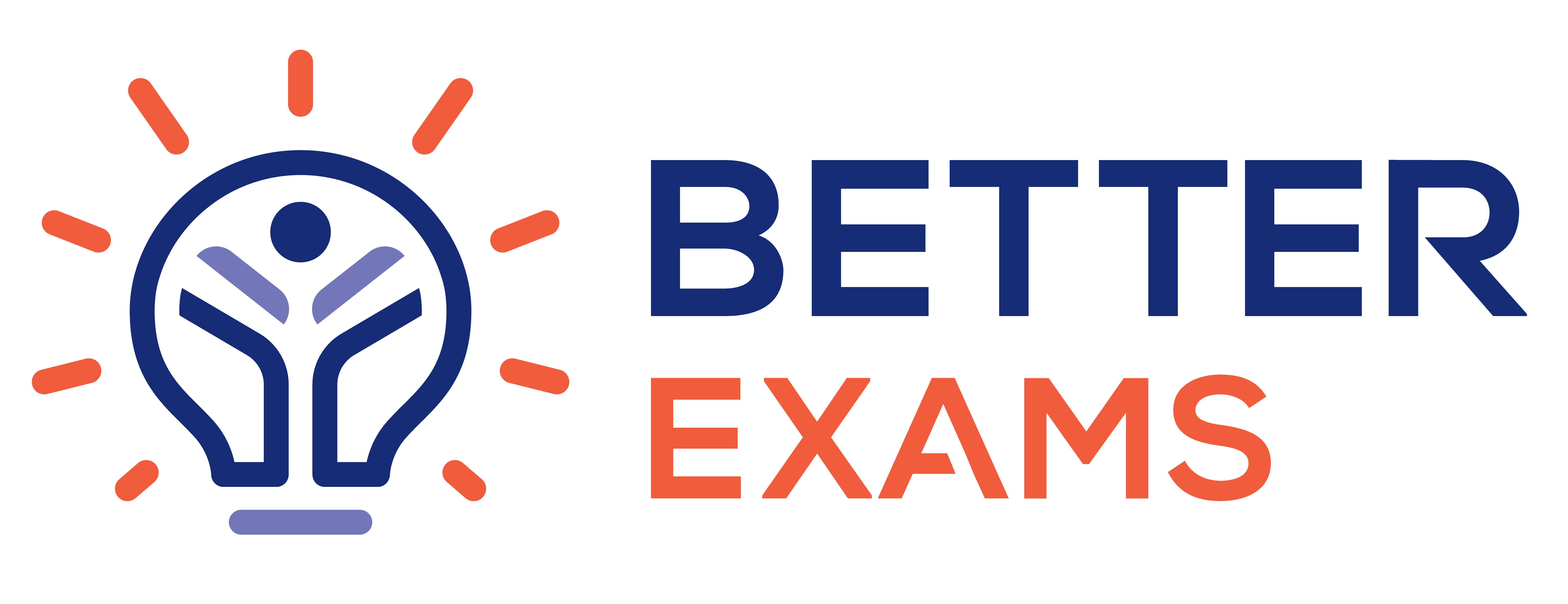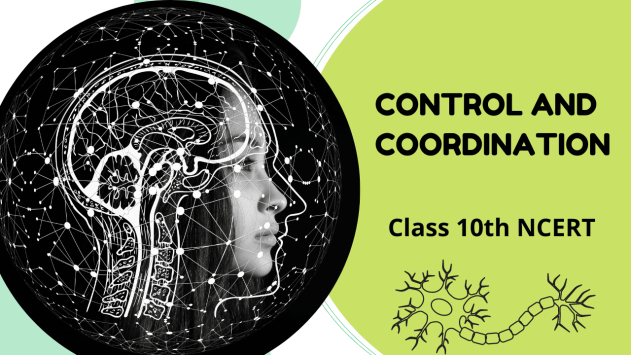We have shared detailed notes of Control And Coordination Class 10th Biology Science NCERT to help the students of class 9th with the solutions and diagrams of Control And Coordination Class 10th.
We have also shared Control And Coordination Class 10th in-depth notes along with NCERT Solutions For Class 10th Control And Coordination, necessary diagrams to remember, and ncert solutions to get the gist of the lesson.
Control And Coordination Class 10th: Introduction
Animals- Nervous System:
The nervous system is the animal organ system to control and coordinates different body activities. The nervous system comprises the brain, the spinal cord, and a vast network of nerves spread throughout the body. The nervous system is responsible for sending, receiving, and processing messages through chemical signals called impulses.
Nervous tissue comprises an organized network of nerve cells or neurons. It is specialized for conducting information via electrical impulses from one body part to another. A neuron is the basic unit of the nervous system. Each neuron consists of three parts: the cell body or cyton, branched projections called the dendrites, and the long process from the cell body, called the axon.
A synapse is a gap between two neurons.
Nerves are thread-like structures emerging out of the brain and spinal cord. Nerves branch out to all parts of the body and are responsible for carrying messages in the body.
Types of nerve cells or neurons
• Sensory nerves send messages to the brain or spinal cord from the sense organs.
• Motor nerves carry messages from the brain or spinal cord to all the muscles and glands
in the body.
• Interneuron or relay neuron connects neurons within specific central nervous system regions. These are neither motor nor sensory.
What happens in reflex actions?
Reflex action: A reflex action, differently known as a reflex, is an involuntary and nearly
instantaneous movement in response to a stimulus. Reflex is an action generated by the body in response to the environment.
The process of detecting a signal or the input and responding to it by an output action might be completed quickly. Such a connection is commonly called a reflex arc. Reflex arcs are formed in the spinal cord itself, although the information input goes on to reach the brain. In higher animals, most sensory neurons do not pass directly into the brain but synapse in the spinal cord. The reflex arc continues to be more efficient for quick response.

Human brain
Types of the nervous system
The nervous system is divided into two systems – the central nervous system and the peripheral nervous system.
Central nervous system: It includes the brain and the spinal cord. It receives information from the body and sends out instructions to particular organs. The brain has three major parts or regions: the forebrain, midbrain, and hindbrain.
• The forebrain is the central thinking part of the brain. It consists of the cerebrum and
diencephalon. The cerebrum is the seat of memory and intelligence and of sensory centers like hearing, smell, and sight. The diencephalon is the seat for pressure and pain.
• The midbrain connects the forebrain to the hindbrain and controls the reflexes for sight and hearing.
• The hindbrain consists of the cerebellum, pons, and medulla. The cerebellum coordinates muscular activities and maintains balance and posture. The medulla controls involuntary activities like blood pressure, salivation, vomiting, and heartbeat.
• The spinal cord extends from the brain’s medulla through the whole vertebral column length and is protected by the vertebral column or backbone. The peripheral nervous system consists of the cranial and spinal nerves arising from the brain and spinal cord.
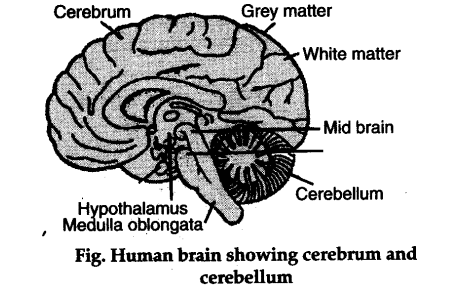
How are the tissues protected?
The human brain is protected by the thick bones of the skull and a fluid called cerebrospinal fluid, which provides further shock absorption.
How does the nervous tissue cause action?
When a nerve impulse reaches the muscle, the muscle fiber must move. The muscle cells will move by changing their shape so that they shorten. Muscle cells have unique proteins that change their shape and arrangement in the cell in response to nervous electrical impulses. When this happens, new arrangements of these proteins give the muscle cells a shorter form.
Control And Coordination Class 10th: Coordination in Plants
All living things respond to environmental stimuli. Plants also respond to stimuli with the help of chemical compounds secreted by the cells. Plants, being living organisms, exhibit some movements. Plants show two types of movement- one dependent on growth and the other independent of growth.
Plants also use electrical chemical means to convey this information from cell to cell, but plants have no specialized tissue to conduct information. Plants respond to stimuli slowly by growing in a particular direction. Because this growth is directional, it appears as if the plant is moving.
Directional movements: These are also called tropic movements. These movements can be either towards the stimulus or away from it.
• Positive phototropism is seen in shoots that respond by bending towards the light. Negative
geotropism is seen in shoots that grow away from the ground.
• Roots bend away from light, exhibiting negative phototropism. They grow towards the ground exhibiting positive geotropism.
• Hydrotropism is a growth response in which water stimuli determine the direction.
• Chemotropism is a growing movement of a plant part in response to a chemical stimulus. e.g.
Growth of pollen tubes towards ovules.
Hormones are chemical compounds released by stimulated cells. Hormones diffuse all
around the cell. They are synthesized at places away from where they act and simply diffuse to the area of action.
Different plant hormones help to coordinate growth, development, and responses to the environment. Different hormones secreted by the plant are auxins, gibberellins, cytokinins, and abscisic acid.
• Auxins are the hormones synthesized at the tip of the stem. These help the plant in growth by cell elongation. Auxin induces shoot apical dominance.
• Gibberellins are hormones that help in the growth of the stem, seed germination, bolting, and flowering.
• Cytokinins are hormones present in the areas of rapid cell division, such as fruits and seeds. They also promote the opening of the stomata.
• Abscisic acid is a hormone that inhibits growth in various parts. It is also responsible for
the closure of stomata. Its effects include wilting of leaves.
Hormones in Animals
The endocrine system is formed by ductless glands that secrete chemical substances called hormones. Endocrine glands release hormones directly into the blood. Hormones are minute, chemical messengers thrown into the blood to act on target organs.
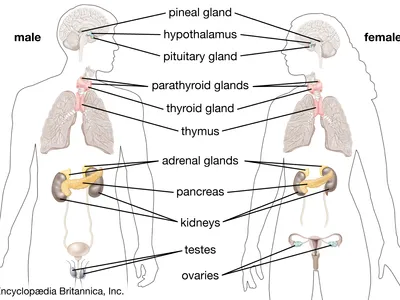
Endocrine glands
Different types of endocrine glands present in our body are the pituitary gland, the pineal gland, the hypothalamus, the thyroid, the parathyroid, the thymus, the adrenal gland, the pancreas, the testes, and the ovary.
The adrenal glands
These are located above the kidneys.
Two regions of the adrenal gland are the adrenal cortex and adrenal medulla.
• Adrenal cortex secretes the hormones like cortisol, aldosterone, and androgens.
• Adrenal medulla secretes the hormones like adrenaline and noradrenaline. Adrenaline is also called the “hormone of fight or flight” or the emergency hormone. It prepares the body to face an emergency condition of physical stress, like danger, anger, and excitement.
The thyroid gland
• It is located in the neck, ventral to the larynx.
• It is one of the most prominent endocrine glands.
• The principal hormones produced by this gland are triiodothyronine and thyroxine.
• Thyroxine is a hormone that regulates the body’s metabolism of carbohydrates, proteins, and fats. Iodine is essential for the synthesis of thyroxin. The deficiency of iodine in food causes goiter. One of the symptoms of this disease is a swollen neck.
The pituitary gland:
• It is located at the base of the brain.
• It is considered the master gland as it secretes many hormones to regulate the organs and the other glands.
• Different hormones secreted by this gland include Growth hormone, TSH, FSH, LH, ACTH,
MSH, Vasopressin, and Oxytocin. Growth hormone regulates the growth and development of the body. If this hormone is deficient in childhood, it leads to dwarfism. Excess
secretion of this hormone leads to gigantism.
Gonads
Two types of gonads present in human beings are female gonads and male gonads.
Female gonads
• A pair of ovaries form the gonads in females.
• Ovaries are the female sex organs on either side of the abdominal cavity. Ovaries
produce two hormones, namely, estrogen and progesterone.
• Oestrogen controls changes during puberty, like feminine voice, soft skin, and
development in mammary glands.
• Progesterone controls uterine changes in the menstrual cycle and helps maintain pregnancy.
Male gonads
• A pair of testes form the gonads in males.
• A pair of testes is the male sex organ located in the scrotum, outside the abdomen.
• Testes produce the hormone testosterone.
• Testosterone controls changes during puberty, like deeper voice,
development of penis, facial and body hair.
Control And Coordination Class 10th: The pancreas
It is located just below the stomach within the curve of the duodenum. It is both exocrine and endocrine in function.
• It secretes hormones such as insulin, glucagon, somatostatin, and pancreatic polypeptide.
• Insulin regulates the sugar level in our blood. Insulin secreted in small amounts increases the sugar level in our blood which in turn causes a disease called diabetes mellitus.
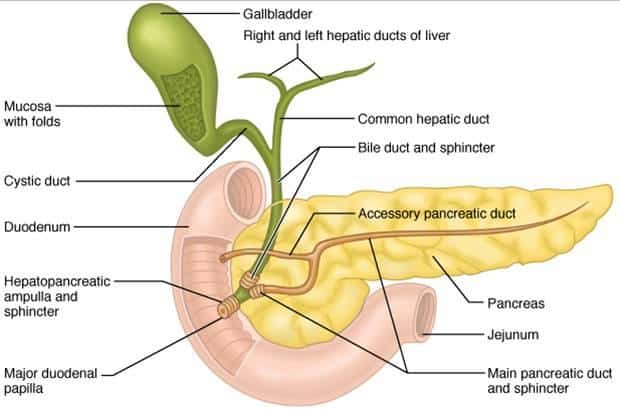
The pineal gland
• It is located near the brain’s center, dorsal to the diencephalon.
• It produces the hormone melatonin.
• Melatonin affects reproductive development, wake and sleep patterns modulation, and seasonal functions.
The hypothalamus:
• It is a neuroendocrine part of the brain.
• It links the nervous and endocrine systems through the pituitary gland.
• Hormones like Somatostatin, Dopamine are secreted by this gland.
Parathyroid glands
• These are two pairs of small, oval-shaped glands embedded on the dorsal surface of the thyroid gland present in the neck.
• They secrete parathormone. It helps regulate calcium and phosphate ions in the bones and blood.
• Hyposecretion leads to tetany, and hypersecretion causes osteoporosis.
The thymus gland
• It is located in front of the heart, in the upper part of the sternum.
• It produces the hormone thymosin.
• It helps in the maturation of T-lymphocytes.
The timing and amount of hormones released are regulated by feedback mechanisms. For example, if the sugar levels in the blood rise, they are detected by the cells of the pancreas, which respond by producing more insulin. As the blood sugar level falls, insulin secretion is reduced.
NCERT Solutions For Class 10th Control And Coordination
Question 1:
Which of the following is a plant hormone?
(a) Insulin
(b) Thyroxin
(c) Oestrogen
(d) Cytokinin.
Answer 1:
(d) Cytokinin is a plant hormone.
Question 2:
The gap between two neurons is called a
(a) dendrite.
(b) synapse.
(c) axon.
(d) impulse.
Answer 2:
(b) The gap between two neurons is called a synapse.
Question 3:
The brain is responsible for
(a) thinking.
(b) regulating the heartbeat.
(c) balancing the body.
(d) all of the above.
Answer 3:
(d) The brain is responsible for thinking, regulating the heart beat and balancing
the body.
Question 4:
What is the function of receptors in our body? Think of situations where receptors
do not work correctly. What problems are likely to arise?
Answer 4:
Receptors are sensory structures (organs/tissues or cells) present throughout the
body. The receptors are grouped in the case of the eye or ear or scattered in the case
of the skin.
Functions of receptors
They sense external stimuli such as heat or pain.
They also trigger an impulse in the sensory neuron, which sends messages
to the spinal cord.
When the receptors are damaged, the external stimuli transferring signals to the
brain are not felt. For example, in the case of damaged receptors, if we
accidentally touch any hot object, then our hands might get burnt as damaged
receptors cannot perceive the external stimuli of heat and pain.
Question 5:
Draw the structure of a neuron and explain its function.
Answer 5:
Neurons are the functional units of the nervous system. The three main parts of a
neuron are the axon, dendrite, and cell body.
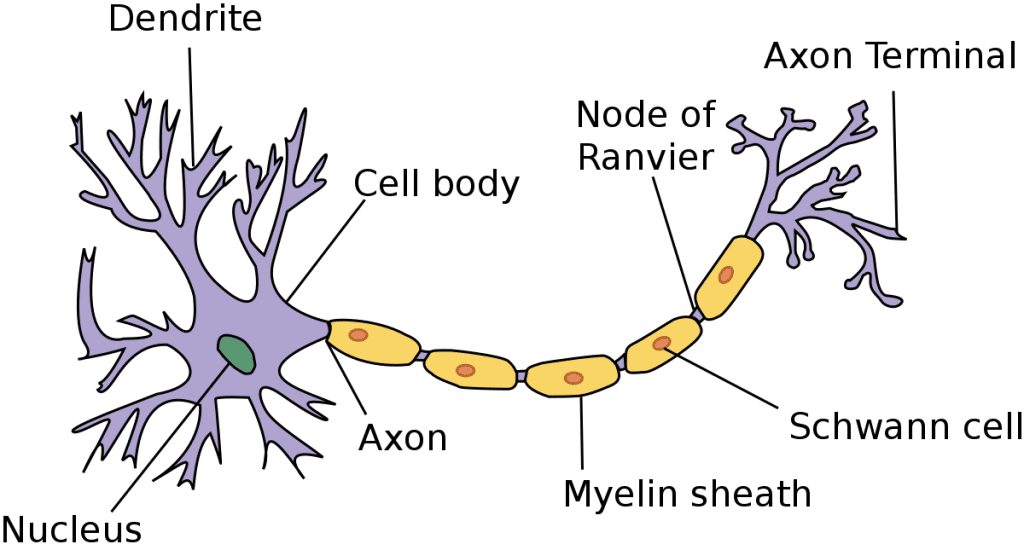
Functions of the three parts of a neuron:
Axon: It conducts messages away from the cell body.
Dendrite: It receives information from the axon of another cell and conducts
the messages towards the cell body.
Cell body: It contains a nucleus, mitochondria, and other organelles. It is
mainly concerned with maintenance and growth.
Question 6:
How does phototropism occur in plants?
Answer 6:
The movement of plants in response to light is called phototropism. Stem shows
positive phototropism as follows:
When growing plants detect light, a hormone called auxin, synthesized at the
shoot tip, helps the cells to grow longer. When the light comes from one side of
the plant auxin diffuses towards the shady side of the shoot. This auxin concentration stimulates the cells to grow longer on the side of the shoot, which is away
from light. Thus, the plant appears to bend towards the light.
Question 7:
Which signals will get disrupted in case of a spinal cord injury?
Answer 7:
The reflex arc connections between the input and output nerves meet in a bundle
in the spinal cord. Nerves from all over the body meet in a bundle in the
spinal cord on their way to the brain. In case of any injury to the spinal cord, the
signals coming from the nerves and the signals coming to the receptors will
be disrupted.
Question 8:
How does chemical coordination occur in plants?
Answer 8:
Animals have a nervous system for controlling and coordinating the body’s activities. But plants have neither a nervous system nor muscles. Plants respond to stimuli by showing movements. The growth, development, and responses to the environment in plants are controlled and coordinated by a particular class of chemical substances known as hormones.
These hormones are produced in one part of the plant body and are translocated to other needy parts. For example, a hormone produced in roots is translocated to other parts when required.
The five major types of phytohormone are auxins, gibberellins, cytokinins, abscisic acid, and ethylene. These phytohormones are either growth promoters (such as auxins, gibberellins, cytokinins, and ethylene) or growth inhibitors such as abscisic acid.
Question 9:
What is the need for a system of control and coordination in an organism?
Answer 9:
The maintenance of the body functions in response to changes in the body by
working together various integrated body systems is known as coordination.
All the movements that respond to stimuli are carefully coordinated and controlled.
In animals, the control and coordination movements are provided by
the nervous and muscular systems. The nervous system sends messages to and away
from the brain. The spinal cord plays a vital role in the relay of messages.
In the absence of this system of control and coordination, our bodies will not be
able to function correctly. For example, when we accidentally touch a hot utensil, we immediately withdraw our hand. Without nerve transmission, we will not withdraw our hands and may get burnt.
Question 10:
How are involuntary actions and reflex actions different from each other?
Answer 10:
Involuntary actions cannot be consciously controlled. For example, we cannot
consciously control the movement of food in the alimentary canal or the pumping of
blood through the heart. These actions are, however, directly under the control of the
brain. On the other hand, reflex actions such as closing eyes immediately
when bright light is focused show sudden response and do not involve any
thinking. This means that, unlike involuntary actions, reflex actions are not
under the control of the brain.
Question 11:
What is the difference between a reflex action and walking?
Answer 11:
A reflex action is a rapid, automatic response to a stimulus. It does not
involve any thinking. For example, we close our eyes immediately when
the bright light is focused.
Walking, on the other hand, is a voluntary action. It is under our conscious
control.
Question 12:
What happens at the synapse between two neurons?
Answer 12:
A very small gap between the last portion of the axon of one neuron and
the dendrite of the other neuron is known as a synapse. It acts as a one-way valve
to transmit impulses in one direction only.
This one-directional transfer of impulses occurs as the chemicals are produced in
only one side of the neuron i.e., the axon’s side. From the axon, the impulses travel
across the synapse to the dendrite of the other neuron.
Question 13:
Which part of the brain maintains posture and equilibrium of the body?
Answer 13:
The Cerebellum, a part of the hindbrain, is responsible for maintaining posture and
equilibrium of the body.
Question 14:
How do we detect the smell of an agarbatti (incense stick)?
Answer 14:
The thinking part of our brain is the forebrain. It has separate areas
specialized for hearing, smelling, sight, taste, touch, etc. The forebrain also has
regions that collect information or impulses from various receptors. When the
smell of an incense stick reaches us, our forebrain detects it.
Then, the forebrain interprets it by combining the information from other receptors and the information already stored in the brain.
Question 15:
What is the role of the brain in reflex action?
Answer 15:
Reflex actions are sudden responses that do not involve any thinking. For
example, when we touch a hot object, we withdraw our hand immediately without
thinking as thinking may take time which would be enough to get us burnt.
The sensory nerves that detect the heat are connected to the nerves that move the
hand muscles. Such a connection of detecting the signal from the nerves
(input) and responding to it quickly (output) is called a reflex arc. The reflex arcs
–connections between the input and output nerves − meet in a bundle in
the spinal cord.
Reflex arcs are formed in the spinal cord, and the information (input) reaches the
brain. The brain is only aware of the signal and the response that has taken place.
However, the brain has no role to play in creating the response.
Question 16:
What are plant hormones?
Answer 16:
Plant hormones or phytohormones are naturally-occurring organic substances.
These are synthesized in one part of the plant body (in minute quantities) and are
translocated to other parts when required.
The five significant phytohormones
are auxins, gibberellins, cytokinins, abscisic acid, and ethylene.
Gibberellins help in the growth of the stem.
Auxins help in the growth of the stem.
Cytokinins promote cell division.
Abscisic acid is one example of a hormone that inhibits growth.
Question 17:
How is the movement of leaves of the sensitive plant different from the movement
of a shoot towards light?
Answer 17:
The movement of leaves of the sensitive plant, Mimosa pudica or “touch
me not,” occurs in response to touch or contact stimuli. This is done by
plant cells by changing the amount of water in leaves. This movement is
independent of growth.
The movement of shooting towards light is known as phototropism. This type
of movement is directional and is growth-dependent.
Question 18:
Give an example of a plant hormone that promotes growth.
Answer 18:
Examples of plants growth hormones:
Gibberellins help in the growth of the stem.
Auxins help in the growth of the stem.
Cytokinins promote cell division.
Question 19:
How do auxins promote the growth of a tendril around a support?
Answer 19:
These tendrils are sensitive to touch. When they come in contact with any support,
auxin (a growth hormone) diffuses from the part of the tendril in contact with the
object to another side, which is not in contact.
Therefore the part of the tendril in the contact with the object does not grow as rapidly as the part of the tendril away from the object. This causes the tendril to circle the object and thus cling to it.
Question 20:
Design an experiment to demonstrate hydrotropism.
Answer 20:
Take two small beakers and label them as A and B. Fill beaker A with water. Make a cylindrical-shaped roll from filter paper and keep it as a bridge between beakers A and B, as shown in the figure. Attach a few germinating seeds in the middle of the filter paper bridge. Cover the entire set-up with a transparent plastic container to retain moisture.
Observation:
The roots of the germinating seeds will grow towards beaker A. This experiment demonstrates the phenomenon of hydrotropism
Question 21:
How does chemical coordination take place in animals?
Answer 21:
Chemical coordination takes place in animals with the help of hormones.
A hormone is a chemical messenger that regulates the physiological processes in
living organisms.
It is secreted by glands. The regulation of physiological processes, control, and coordination by hormones comes under the endocrine system. The nervous system, along with the endocrine system in our body, controls and coordinates the physiological processes.
Question 22:
Why is the use of iodized salt advisable?
Answer 22:
Iodine stimulates the thyroid gland to produce thyroxin hormone. It regulates
carbohydrate, fat, and protein metabolism in our bodies. Deficiency of this hormone results in the enlargement of the thyroid gland. This can lead to goiter, a disease characterized by a swollen neck. Therefore, iodized salt is advised for normal functioning of the thyroid gland.
Question 23:
How does our body respond when adrenaline is secreted into the blood?
Answer 23:
Adrenalin is a hormone secreted by the adrenal glands in case of any danger, emergency, or stress. It is secreted directly into the blood and transported to different body parts.
When secreted in large amounts speeds up the heartbeat and supplies
more oxygen to the muscles. The breathing rate also increases due to contractions
of the diaphragm and rib muscles. It also increases blood pressure. All these
responses enable the body to deal with any stress or emergency.
Question 24:
Why are some patients with diabetes treated by giving injections of insulin?
Answer 24:
Diabetes is a disease in which the blood sugar level is too high. Insulin, a hormone secreted by the pancreas, helps regulate blood sugar levels. This is the reason why diabetic patients are treated by giving injections.
Conclusion
We have shared in detail notes of Control And Coordination Class 10th to help the students with the lesson Control And Coordination Class 10th Science NCERT so they can better understand the lesson.
